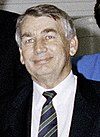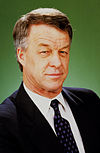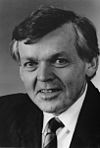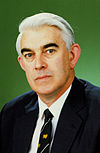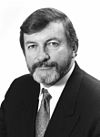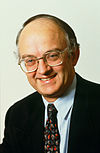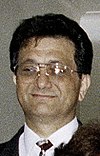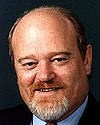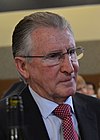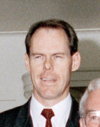
Robert James Lee Hawke was an Australian politician who served as the 23rd prime minister of Australia from 1983 to 1991, holding office as the leader of the Australian Labor Party (ALP). He was a member of parliament (MP) for the division of Wills from 1980 to 1992.

Paul John Keating is an Australian former politician who served as the 24th prime minister of Australia from 1991 to 1996. A member of the Australian Labor Party (ALP), he previously served as treasurer of Australia in the Hawke Government from 1983 to 1991 and as deputy prime minister of Australia from 1990 to 1991.

Simon Findlay Crean is an Australian politician and trade unionist. He was the Member of Parliament for Hotham from 1990 to 2013, representing the Labor Party, and served as a Cabinet Minister in the Hawke, Keating, Rudd and Gillard Governments. He was the Leader of the Labor Party and Leader of the Opposition from November 2001 to December 2003.

The Attorney-General of Australia is the First Law Officer of the Crown in right of the Commonwealth of Australia, chief law officer of the Commonwealth of Australia and a minister of state. The Attorney-General is usually a member of the Federal Cabinet, but need not be. Under the Constitution, they are appointed by the Governor-General on the advice of the Prime Minister, and serve at the Governor-General's pleasure. In practice, the Attorney-General is a party politician and their tenure is determined by political factors. By convention, but not constitutional requirement, the Attorney-General is a lawyer by training.
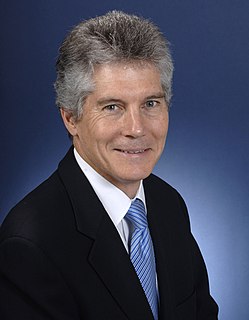
Stephen Francis Smith is a former Australian politician who was a member of the House of Representatives from 1993 to 2013. He served as a minister in the Rudd and Gillard Governments, including as Minister for Foreign Affairs (2007–2010), Minister for Trade (2010), and Minister for Defence (2010–2013).
The Second Hawke Ministry (Labor) was the 55th ministry of the Government of Australia. It was led by the country's 23rd Prime Minister, Bob Hawke. The Second Hawke Ministry succeeded the First Hawke Ministry, which dissolved on 13 December 1984 following the federal election that took place on 1 December. The ministry was replaced by the Third Hawke Ministry on 24 July 1987 following the 1987 federal election.
The Third Hawke Ministry (Labor) was the 56th ministry of the Government of Australia. It was led by the country's 23rd Prime Minister, Bob Hawke. The Third Hawke Ministry succeeded the Second Hawke Ministry, which dissolved on 24 July 1987 following the federal election that took place on 11 July. The ministry was replaced by the Fourth Hawke Ministry on 4 April 1990 following the 1990 federal election.
The Fourth Hawke Ministry (Labor) was the 57th ministry of the Government of Australia. It was led by the country's 23rd Prime Minister, Bob Hawke. The Fourth Hawke Ministry succeeded the Third Hawke Ministry, which dissolved on 4 April 1990 following the federal election that took place on 24 March. The ministry was replaced by the First Keating Ministry on 20 December 1991 following the resignation of Hawke as Prime Minister after a successful leadership challenge by Paul Keating.
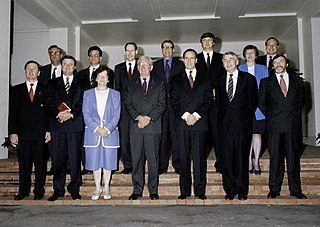
The Second Keating Ministry (Labor) was the 59th ministry of the Government of Australia. It was led by the country's 24th Prime Minister, Paul Keating. The Second Keating Ministry succeeded the First Keating Ministry, which dissolved on 24 March 1993 following the federal election that took place on 13 March. The ministry was replaced by the First Howard Ministry on 11 March 1996 following the federal election that took place on 2 March which saw the Liberal–National Coalition defeat Labor.
Ralph Willis AO is a former Australian politician who served as a Cabinet Minister during the entirety of the Hawke-Keating Government from 1983 to 1996, most notably as Treasurer of Australia from 1993 to 1996 and briefly in 1991. He also served as Minister for Industrial Relations, Minister for Transport and Communications and Minister for Finance. He represented the Victorian seat of Gellibrand in the House of Representatives from 1972 to 1998.

John Sydney "Joe" Dawkins, AO is an Australian former politician who was Treasurer in the Keating Labor government from December 1991 to December 1993. He is notable for his reforms of tertiary education as Minister for Employment, Education and Training, his period as Treasurer when he attempted to increase taxes in order to balance the budget and his abrupt exit from politics.
The following lists events that happened during 1991 in Australia.
Peter Staples is an Australian former politician for the Australian Labor Party. He was first elected to Parliament in 1983 as the Member for Diamond Valley. When Diamond Valley was abolished in 1984, Staples transferred to the newly created Jagajaga, essentially the western half of his old electorate. In 1987, he was appointed Consumer Affairs Minister by Prime Minister Bob Hawke in his third ministry. Staples would remain a junior minister for nearly six years, serving as Minister for Housing and Aged Care and later Aged, Family and Health Services in the Hawke and Keating Ministries.
Ross Vincent Free is a former Australian politician who served as a Labor member of the Australian House of Representatives representing the seat of Macquarie from 1980 until 1984, then Lindsay from 1984 until 1996. He served as a minister from 1990 until 1996 in both the Hawke and Keating ministries.
Wendy Frances Fatin is a retired Australian politician. She was a member of the Australian Labor Party (ALP) and was the first woman from Western Australia elected to the House of Representatives, representing the division of Canning (1983–1984) and Brand (1984–96). She held ministerial office in the Hawke and Keating Governments, serving as Minister for Local Government (1990–1991), Minister assisting the Prime Minister for the Status of Women (1990–1993), and Minister for the Arts and Territories (1991–1993).

The Hawke–Keating Government is an all-encompassing term to describe the duration of the Hawke Government and the Keating Government, which together spanned from 11 March 1983 to 11 March 1996. Both governments were formed by the Australian Labor Party, and were led from 1983 to 1991 by Bob Hawke as Prime Minister, and from 1991 to 1996 by Paul Keating as Prime Minister, with Keating serving as Treasurer throughout the Hawke Government. During the Hawke–Keating Government, the Labor Party won five successive federal elections, its most electorally successful period to date; the 13-year uninterrupted period of government also remains the Labor Party's longest spell in power at the federal level.

The Hawke Government was the federal executive government of Australia led by Prime Minister Bob Hawke of the Australian Labor Party (ALP) from 1983 to 1991. The Government followed the Liberal-National Coalition Fraser Government and was succeeded by another Labor administration, the Keating Government, led by Paul Keating after an internal party leadership challenge in 1991. Keating served as Treasurer through much of Hawke's term as Prime Minister and the period is sometimes termed the Hawke-Keating Government.

The Keating Government was the federal executive government of Australia led by Prime Minister Paul Keating of the Australian Labor Party from 1991 to 1996. The Government followed on from the Hawke Government after Paul Keating replaced Bob Hawke as Labor leader in an internal party leadership challenge in 1991. Together, these two governments are often collectively described as the Hawke-Keating Government. The Keating Government was defeated in the 1996 federal election and was succeeded by the Howard Coalition government.

A leadership spill of the Australian Labor Party (ALP), the party of government in the Parliament of Australia, was held on 19 December 1991, the second spill in a year. Backbencher and former Treasurer Paul Keating defeated Prime Minister Bob Hawke, who had led Labor for eight and a half years.

A leadership spill in the Australian Labor Party, the party of government in the Parliament of Australia, was held on 3 June 1991. It was the first of two ballots that year with Prime Minister Bob Hawke surviving the ballot against Treasurer Paul Keating, who then went to the backbench.


